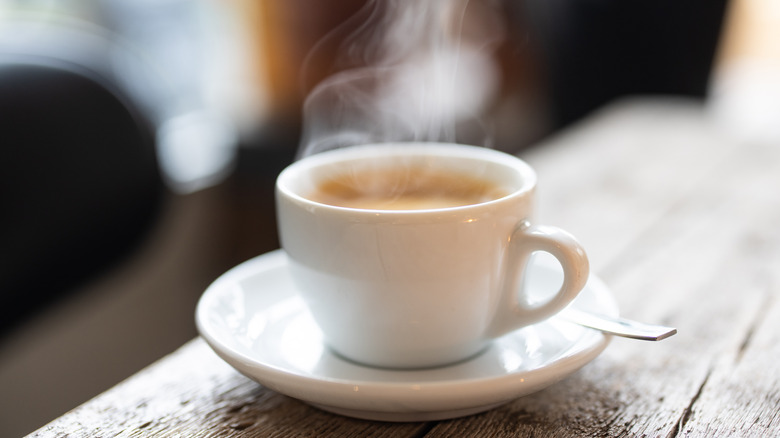The Part Of Your Espresso Experts Want You To Stop Drinking
A good espresso has several characteristics that make it stand out. For one it has a strong, pleasant aroma that includes notes of chocolate, caramel, and fruit. It should have a well-balanced flavor profile that includes both sweetness and bitterness, and it has a rich, full-bodied texture. One of the most important aspects of a good espresso, though, is a thick layer of crema on top, which should be a rich, reddish-brown color.
Crema has a rich, smooth, velvety texture and it contains a lot of the coffee's flavor and aroma. A thick crema indicates that the espresso was brewed with fresh, high-quality beans, while a thin crema may indicate that the espresso was brewed incorrectly or with low-quality beans. The taste varies depending on the type of coffee beans used and the brewing method, but it generally has a slightly sweet and nutty flavor. Some people also describe it as having a bitter taste, and it coats your tongue, giving espresso a heavy texture. While many people like these characteristics, some coffee experts think you should remove the crema to cut down the bitterness.
Ways to remove crema and bitterness from espresso
Crema is created during the brewing process as hot water is forced through compacted, finely ground beans at high pressure, which causes carbon dioxide to be released from the beans and mixed with the coffee oils. This creates that creamy layer on top of the espresso. In an interview with Food & Wine, Norwegian barista and coffee roaster Kenneth Robertsen said that crema makes espresso "a lot more bitter. If you mix it in, or take it off, you'll get a totally different experience."
If you think crema makes your espresso too bitter or too heavy, simply scrape it off the top using a butter knife or a spoon. You can also try stirring it to mix the crema into the espresso and distribute the flavors more evenly. This results in a more well-rounded espresso that still has some bitterness, but not as much as straight crema. Jon Dail, owner of Grind Coffee House and former SoCal regional AeroPress champion, told Barista Magazine that he thinks you should "always stir your espresso."
How to adjust your crema
If you like the crema, but think your espresso could be better with less, you can change the amount of crema that's produced during the brewing process by adjusting the grind of your beans, the water pressure, and brewing time and temperature. A finer grind will result in a stronger and potentially more bitter espresso and crema, so for less bitterness you need a coarser setting. This will also give you a thinner crema, which will dissipate faster or stir in more evenly. Be careful not to leave the beans too coarse, though, as that can result in weak espresso.
If you brew espresso for longer than 30 seconds, you may end up with a thick white foam, which will be bland and bitter. Reducing the brewing time gives you a thinner crema and a milder taste. Older coffee beans will also result in a thinner crema, because they are more dried out than fresher beans, so they have less oils to add to the brewing process.


